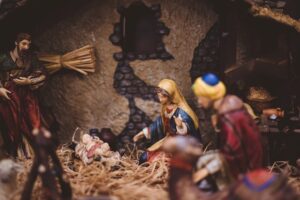 Catholics have a long history of appreciating and creating art, and there are several reasons why art is important to the Church and its members.
Catholics have a long history of appreciating and creating art, and there are several reasons why art is important to the Church and its members.
First and foremost, art has the power to evoke a sense of beauty and awe that can help people connect with the divine. Whether it is a painting of a religious figure, a stained glass window depicting a biblical scene, or a sculpture of a saint, Catholic art has the ability to inspire and uplift the viewer, and to help them feel a deeper sense of connection to God.
Art is also important to the Church because it provides a way to communicate and reinforce important religious ideas and teachings. By using symbols, imagery, and allegory, Catholic art can convey complex theological concepts in a way that is accessible and understandable to a wide audience. Art can also serve as a way to connect people to the history and traditions of the Church, by depicting important events and figures from its past.
In addition to its spiritual and educational value, art is also an important part of Catholic culture and heritage. From the intricately decorated cathedrals of Europe to the vibrant religious art scenes in Latin America, Catholic art has played an important role in shaping the cultural identity of the Church and its members around the world.
Finally, art is important to Catholics because it provides a way for people to express their faith and devotion. Whether it is through painting, sculpture, music, or other forms of artistic expression, Catholics can use art as a way to express their love for God and their desire to live a life that is guided by the principles of the Church.
In summary, art is important to Catholics for many reasons, including its ability to inspire, educate, connect people to the Church’s history and traditions, and provide a way for people to express their faith and devotion.
Here is a brief overview of the major art movements and periods within the context of Catholic art history:
Early Middle Ages: During the Early Middle Ages, Christian art was largely focused on illuminated manuscripts, such as the Book of Kells, which is an intricately decorated copy of the four Gospels produced by Celtic monks in the 9th century. Another example is the Lindisfarne Gospels, which were created by monks on the island of Lindisfarne in the 7th century.
Romanesque: Romanesque art is often associated with the building of churches and cathedrals, such as the Abbey Church of Sainte-Foy in Conques, France, which features elaborate carvings and sculptures. Another example is the Pisa Baptistery in Italy, which features a striking octagonal design and intricate decorative details.
Gothic: Gothic art is perhaps best exemplified by the architecture of churches and cathedrals, such as Notre Dame in Paris, which features soaring, pointed arches and intricate stained glass windows. Sculpture was also an important form of Gothic art, with notable examples including the facade of the Cathedral of Santiago de Compostela in Spain, which features a depiction of Christ surrounded by the apostles.
Renaissance: Renaissance art is perhaps best known for its painting and sculpture, with notable artists including Leonardo da Vinci, Michelangelo, and Raphael. Some examples of significant works from this era include Michelangelo’s Sistine Chapel ceiling frescoes, which depict scenes from the Bible, and Leonardo da Vinci’s “Last Supper,” which depicts the moment when Jesus shared a final meal with his disciples.
Council Of Trent: As part of the Church’s efforts to promote more “orthodox” forms of art, many artists during this period produced works that were explicitly religious in nature. One example is Caravaggio, an Italian painter whose works often depicted biblical scenes, such as his “Conversion of Saint Paul” and “Supper at Emmaus.”
Baroque: Baroque art is characterized by its dramatic, dynamic, and ornate style, which was used to depict religious subjects with a heightened sense of emotion and drama. One example is Gian Lorenzo Bernini’s sculpture “The Ecstasy of Saint Teresa,” which depicts the mystic saint in a moment of intense spiritual experience.
18th Century: During the 18th century, Catholic art continued to focus on religious subjects, with notable examples including Francisco de Goya’s “The Immaculate Conception,” which depicts the Virgin Mary surrounded by a halo of light.
19th And 20th Centuries: This period was marked by significant changes in Catholic art, with artists exploring a wide range of styles and mediums. Some examples include Marc Chagall’s stained glass windows in the cathedral of Metz, France, and the work of Salvador Dali, who created a number of religious-themed paintings, including “The Crucifixion.”
21st Century: In recent years, Catholic art has continued to evolve, with artists incorporating a wide range of styles and mediums into their work. Some examples include contemporary installations in churches and cathedrals, such as Spencer Finch’s “The River That Flows Both Ways” in New York’s Cathedral of Saint John the Divine, and digital art, such as Bill Viola’s “The Martyrs,” which depicts individuals experiencing spiritual transcendence in the face of death.